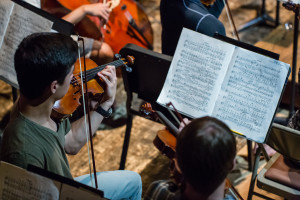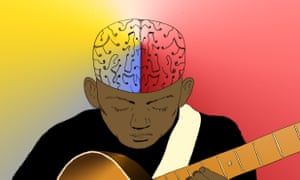 Dear Board of Education Members:
Dear Board of Education Members:
Usually someone like me is writing to you at the end of the year, pleading for no cuts to be made to our arts programs. But I decided to be proactive and write this at thebeginning of the year — instead focusing on discussing with you ways in which our programs should grow and prosper, not just survive.
Too often, our community is forced to defend the arts in the face of budget season, but we can do better than this. We need to utilize this “quieter” time of year to not only celebrate the arts in education, but to discuss ways to fully incorporate it into the lives of our children so that we rarely need to discuss dismantling our programs ever again.
I believe it’s important to start this year by reminding ourselves of what the goal of our community is in regards to the education of our children. In my view, we are charged with at least these three things:
- We’re teaching our students skills necessary for entering the global workforce — but let’s be careful with this. We are preparing them for jobs that do not exist yet due to the speed at which technology is changing the world, so using an “Industrial Revolution model” of education is no longer appropriate.
- We’re preparing them to be great citizens.
- We’re teaching them to be great human beings — people who can enjoy the deeper forms of beauty, and thus think creatively and in innovative ways about the two points listed above.
During these times of tough budget choices, music advocates such as myself are constantly forced into speaking to the tangible benefits of arts education to ensure it remains a vital part of our public education system. In this case, we need to discuss more about how the arts can become a more vital part of the system in tangible and intangible (non-tested) ways.
Here are reasons I believe music and the arts have a profound impact on our school system, and some ideas to incorporate the arts into each and every school day:
Music is a core part of our life. Before we discuss ways music and the arts “helps” academics, let’s first make a strong statement as a school community that all young people should participate in the arts because it’s central to every human society on earth and has an unbelievably important role in every aspect of culture; including history, literature, media and ways in which we communicate. The intrinsic value of the arts and their role in our daily lives and society — and the importance of helping young people understand and appreciate that value and role — should be at the forefront of our educators’ and administrators’ minds.
Music education can close our achievement gap. The definition of our Achievementt Gap has almost everything to do with the results of standardized testing. While I personally believe that a student’s success should not be determined by test scores, let’s play that game while referencing some data:
Not only do the arts improve standardized test scores, a 2012 report from the National Endowment for the Arts showed that, by nearly every indicator studied, a student from a low-socioeconomic (SES) background with a high-arts educational experience significantly outperformed peers from a low-arts, low-SES background, closing (and in some cases eliminating) the gap that often appears between low-SES students and their more advantaged peers. These improvements were in graduation rates, college attendance and completion rates, and science and writing scores on the National Assessment of Educational Progress (NAEP).
My point is that we have tried giving SES students “more school” to boost test scores, and not only has it barely worked — it’s not making them like school any more than they already do (and many are miserable). What if we engaged them in an artistic and creative manner and test scores go up as a result? When are we going to try something different?
Top-down mandates are one thing, but implementation in the classroom is another. If we continue to create school schedules that are solely based on state mandates without any creative implementation on our part, our children lose. Besides, these mandates and educational fads are changing all the time, leaving us reactive and scrambling to conform instead of proactive and placing the mandates “where they belong”. Whatever our educational leaders say about the arts, they measure achievement through math and language arts scores, not drawing proficiency or music skills. It’s no surprise then that our district has zeroed in on the tests. We can do better, and we have the capacity to decide to be ahead of the curve regarding education reform if we choose to do so.
We need to narrow the “opportunity gap.” While we continue to keep up with these state mandates and new testing fads, our economically disadvantaged kids lose out big time. They are the ones who see more contact time in academic subjects at the expense of the music and the arts, yet they are the ones who may benefit most from music’s benefits: enhanced brain development, spatial/visual/temporal processing, improving memory and attention, physical coordination, personal discipline and teamwork. Consider the fact that students with access to arts education have higher attendance rates and lower drop out rates, and that the arts engage the parents and families of students who are involved in performances and recitals. Why wouldn’t we make the arts available to at-risk students in abundance?
Creativity is learned and it must be a habit, so we need to create innovative school schedules. Like any other learned skill, creativity must become a habit in order for it to “stick”. One day a week of the arts in the school schedule, especially in the earlier grades, is a far shot from teaching creativity. How would we build a “perfect” school day for our students if there were no state mandates? Let’s start there. That ideal schedule would reflect our true values as a community and act as a powerful starting point for building a schedule that works for all children. There are no perfect schedules, but a carefully planned schedule should include flexibility that will positively impact teaching, instruction, and professional development in the arts.
We need to train every single teacher in the arts. A curriculum rich in the arts is a more engaging curriculum for all. We need to pool our resources and provide professional development opportunities throughout the year to give our teachers step-by-step strategies to teach in and through the arts. This will greatly help our teachers bring art and music into their students’ everyday classroom experience. Through this development, our teachers can learn to teach the “whole child” and reach students who may struggle with traditional approaches to learning — students who have been “lost” in our test-rich system until now. This will be some of the best money we have ever spent for our schools.
I am writing this because, like you, I want to see the students in our schools succeed, and I’ve seen first-hand the powerful impact arts education can have on students’ academic success. Our arts-centered school reform initiatives can engage students and teachers, improve our schools’ climates and cultures, and help connect our schools to families and communities. We need to do everything we can to fuel students’ imaginations and creativity; the arts will enhance students problem-solving and critical thinking skills, which aid their learning in other subject areas. An education in the arts exposes students to a variety of cultures while enriching their learning experience and teaching them how to be empathetic, tolerant and open to working with others — all necessary skills for success in our multi-cultural society.
Music and arts education should not be a luxury in our district. Creativity isn’t only reserved for artists and musicians, so let’s turn this problem on its head and share the belief that the arts as the nucleus of an education are essential for every child. Learning to create and appreciate visual and aural aesthetics is more important than ever before to the development of the next generation of great thinkers, innovators, and human beings.
We have tried the way of the almighty test. Let’s try something different.
Sincerely,
An Optimistic Parent







